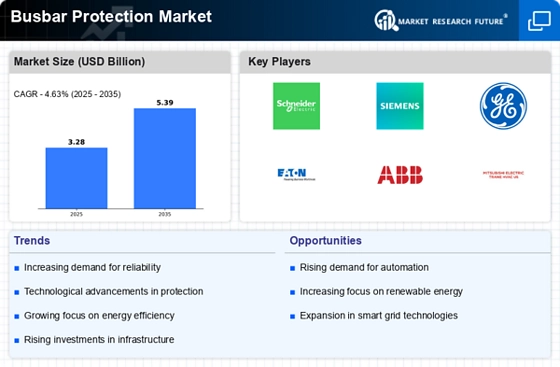Increasing Urbanization
The rapid pace of urbanization is driving the Busbar Protection Market as cities expand and require more robust electrical infrastructure. Urban areas are experiencing a surge in population, leading to increased demand for reliable power distribution systems. This trend necessitates the installation of advanced busbar protection systems to ensure the safety and efficiency of electrical networks. According to recent data, urban centers are projected to account for over 70% of global energy consumption by 2030, highlighting the critical need for effective busbar protection solutions. As urbanization continues, the Busbar Protection Market is likely to witness substantial growth, with investments in infrastructure upgrades and new installations becoming paramount.
Rising Renewable Energy Integration
The transition towards renewable energy sources is significantly influencing the Busbar Protection Market. As countries strive to meet sustainability goals, the integration of solar, wind, and other renewable energy systems into existing grids is becoming increasingly common. This shift necessitates enhanced protection mechanisms to manage the complexities associated with variable energy sources. The International Energy Agency indicates that renewable energy could account for nearly 50% of global electricity generation by 2030. Consequently, the demand for sophisticated busbar protection systems that can accommodate these changes is expected to rise, driving innovation and investment in the Busbar Protection Market.
Regulatory Compliance and Safety Standards
Stringent regulatory frameworks and safety standards are compelling utilities and industries to invest in advanced busbar protection systems. Governments and regulatory bodies are increasingly emphasizing the importance of electrical safety and reliability, leading to the implementation of comprehensive guidelines. Compliance with these regulations is essential for avoiding penalties and ensuring operational continuity. The Busbar Protection Market is likely to benefit from this trend, as organizations seek to enhance their safety protocols and minimize risks associated with electrical failures. The growing awareness of safety standards is expected to propel the demand for innovative busbar protection solutions, thereby fostering market growth.
Technological Innovations in Protection Systems
Technological advancements are reshaping the Busbar Protection Market, with innovations in protection systems enhancing their efficiency and reliability. The development of digital relays, smart sensors, and automated monitoring systems is enabling more precise fault detection and response. These technologies not only improve the operational performance of busbar systems but also reduce maintenance costs. The market for smart protection solutions is projected to grow significantly, as industries increasingly adopt these technologies to optimize their electrical networks. As a result, the Busbar Protection Market is poised for expansion, driven by the demand for cutting-edge protection solutions that ensure uninterrupted power supply.
Growing Industrialization and Infrastructure Development
The ongoing industrialization and infrastructure development across various sectors are propelling the Busbar Protection Market. As industries expand and new facilities are established, the need for reliable power distribution systems becomes paramount. This trend is particularly evident in emerging economies, where significant investments are being made in manufacturing, construction, and energy sectors. The International Monetary Fund projects that infrastructure investment in developing regions will exceed trillions of dollars in the coming years. Consequently, the demand for effective busbar protection systems is expected to rise, as industries seek to enhance their electrical infrastructure and ensure operational efficiency.


















Leave a Comment